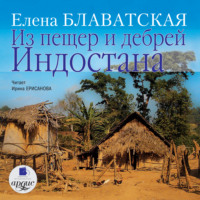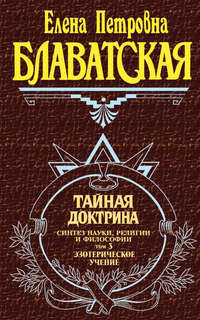 полная версия
полная версияFrom the Caves and Jungles of Hindostan
The sacrifice of the goat is very interesting, so I am going to describe it in detail.
A child of the male sex is sent to invite several married ladies, old women of twenty or twenty-five, to witness the worship of the Lares and Penates. Each family has a household goddess of its own—which is not impossible, since the Hindu gods number thirty-three crores. On the eve of the sacrificial day, a kid is brought into the house, and all the family sleep round him. Next morning, the reception hall in the lower story is made ready for the ceremony. The floor is thickly covered with cow-dung, and, right in the middle of the room a square is traced with white chalk, in which is placed a high pedestal, with the statue of the goddess. The patriarch of the family brings the goat, and, holding him by the horns, lowers his head to salute the goddess. After this, the "old" and young women sing marriage hymns, tie the legs of the goat, cover his head with red powder, and make a lamp smoke under his nose, to banish the evil spirits from round him. When all this is done, the female element puts itself out of the way, and the patriarch comes again upon the stage. He treacherously puts a ration of rice before the goat, and as soon as the victim becomes innocently absorbed in gratifying his appetite, the old man chops his head off with a single stroke of his sword, and bathes the goddess in the smoking blood coming from the head of the animal, which he holds in his right arm, over the idol. The women sing in chorus, and the ceremony of betrothal is over.
The ceremonies with the astrologers, and the exchange of presents, are too long to be described. I shall mention only, that in all these ceremonies the astrologer plays the double part of an augur and a family lawyer. After a general invocation to the elephant-headed god Ganesha, the marriage contract is written on the reverse of the horoscopes and sealed, and a general blessing is pronounced over the assembly.
Needless to say that all these ceremonies had been accomplished long ago in the family to whose marriage party we were invited in Bagh. All these rites are sacred, and most probably we, being mere strangers, would not have been allowed to witness them. We saw them all later on in Benares—thanks to the intercession of our Babu.
When we arrived on the spot, where the Bagh cere-mony was celebrated, the festivity was at its height. The bridegroom was not more than fourteen years old, while the bride was only ten. Her small nose was adorned with a huge golden ring with some very brilliant stone, which dragged her nostril down. Her face looked comically piteous, and sometimes she cast furtive glances at us. The bridegroom, a stout, healthy-looking boy, attired in cloth of gold and wearing the many storied Indra hat, was on horseback, surrounded by a whole crowd of male relations.
The altar, especially erected for this occasion, presented a queer sight. Its regulation height is three times the length of the bride's arm from the shoulder down to the middle finger. Its materials are bricks and white-washed clay. Forty-six earthen pots painted with red, yellow and green stripes—the colors of the Trimurti—rose in two pyramids on both sides of the "god of marriages" on the altar, and all round it a crowd of little married girls were busy grinding ginger. When it was reduced to powder the whole crowd rushed on the bridegroom, dragged him from his horse, and, having undressed him, began rubbing him with wet ginger. As soon as the sun dried him he was dressed again by some of the little ladies, whilst one part of them sang and the other sprinkled his head with water from lotus leaves twisted into tubes. We understood that this was a delicate attention to the water gods.
We were also told that the whole of the previous night had been given up to the worship of various spirits. The last rites, begun weeks ago, were hurriedly brought to an end during this last night. Invocations to Ganesha, to the god of marriages; to the gods of the elements, water, fire, air and earth; to the goddess of the smallpox and other illnesses; to the spirits of ancestors and planetary spirits, to the evil spirits, good spirits, family spirits, and so on, and so on. Suddenly our ears were struck by strains of music.... Good heavens! what a dreadful symphony it was! The ear-splitting sounds of Indian tom-toms, Tibetan drunis, Singalese pipes, Chinese trumpets, and Burmese gongs deafened us on all sides, awakening in our souls hatred for humanity and humanity's inventions.
"De tous les bruits du monde celui de la musique est le plus desagreable!" was my ever-recurring thought. Happily, this agony did not last long, and was replaced by the choral singing of Brahmans and nautches, which was very original, but perfectly bearable. The wedding was a rich one, and so the "vestals" appeared in state. A moment of silence, of restrained whispering, and one of them, a tall, handsome girl with eyes literally filling half her forehead, began approaching one guest after the other in perfect silence, and rubbing their faces with her hand, leaving traces of sandal and saffron powders. She glided towards us also, noiselessly moving over the dusty road with her bare feet; and before we realized what she was doing she had daubed me as well as the colonel and Miss X–, which made the latter sneeze and wipe her face for at least ten minutes, with loud but vain utterances of indignation.
The Babu and Mulji offered their faces to the little hand, full of saffron, with smiles of condescending generosity. But the indomitable Narayan shrank from the vestal so unexpectedly at the precise moment when, with fiery glances at him, she stood on tiptoe to reach his face, that she quite lost countenance and sent a full dose of powder over his shoulder, whilst he turned away from her with knitted brow. Her forehead also showed several threatening lines, but in a moment she overcame her anger and glided towards Ram-Runjit-Das, sparkling with engaging smiles. But here she met with still less luck; offended at once in his monotheism and his chastity, the "God's warrior" pushed the vestal so unceremoniously that she nearly upset the elaborate pot-decoration of the altar. A dissatisfied murmur ran through the crowd, and we were preparing to be condemned to shameful banishment for the sins of the warlike Sikh, when the drums sounded again and the procession moved on. In front of everyone drove the trumpeters and the drummers in a car gilded from top to bottom, and dragged by bullocks loaded with garlands of flowers; next after them walked a whole detachment of pipers, and then a third body of musicians on horseback, who frantically hammered huge gongs. After them proceeded the cortege of the bridegroom's and the bride's relations on horses adorned with rich harness, feathers and flowers; they went in pairs. They were followed by a regiment of Bhils in full disarmour—because no weapons but bows and arrows had been left to them by the English Government. All these Bhils looked as if they had tooth-ache, because of the odd way they have of arranging the ends of their white pagris. After them walked clerical Brahmans, with aromatic tapers in their hands and surrounded by the flitting battalion of nautches, who amused themselves all the way by graceful glissades and pas. They were followed by the lay Brahmans—the "twice born." The bridegroom rode on a handsome horse; on both sides walked two couples of warriors, armed with yaks' tails to wave the flies away. They were accompanied by two more men on each side with silver fans. The bridegroom's group was wound up by a naked Brahman, perched on a donkey and holding over the head of the boy a huge red silk umbrella. After him a car loaded with a thousand cocoa-nuts and a hundred bamboo baskets, tied together by a red rope. The god who looks after marriages drove in melancholy isolation on the vast back of an elephant, whose mahout led him by a chain of flowers. Our humble party modestly advanced just behind the elephant's tail.
The performance of rites on the way seemed endless.
We had to stop before every tree, every pagoda, every sacred tank and bush, and at last before a sacred cow. When we came back to the house of the bride it was four in the afternoon, and we had started a little after six in the morning. We all were utterly exhausted, and Miss X– literally threatened to fall asleep on her feet. The indignant Sikh had left us long ago, and had persuaded Mr. Y– and Mulji—whom the colonel had nicknamed the "mute general"—to keep him company. Our respected president was bathed in his own perspiration, and even Narayan the unchangeable yawned and sought consolation in a fan. But the Babu was simply astonishing. After a nine hours' walk under the sun, with his head unprotected, he looked fresher than ever, without a drop of sweat on his dark satin-like forehead. He showed his white teeth in an eternal smile, and chaffed us all, reciting the "Diamond Wedding" of Steadman.
We struggled against our fatigue in our desire to wit-ness the last ceremony, after which the woman is forever cut off from the external world. It was just going to begin; and we kept our eyes and ears wide open.
The bridegroom and the bride were placed before the altar. The officiating Brahman tied their hands with some kus-kus grass, and led them three times round the altar. Then their hands were untied, and the Brahman mumbled a mantram. When he had finished, the boy husband lifted his diminutive bride and carried her three times round the altar in his arms, then again three turns round the altar, but the boy preceding the girl, and she following him like an obedient slave. When this was over, the bridegroom was placed on a high chair by the entrance door, and the bride brought a basin of water, took off his shoes, and, having washed his feet, wiped them with her long hair. We learned that this was a very ancient custom. On the right side of the bridegroom sat his mother. The bride knelt before her also, and, having performed the same operation over her feet, she retired to the house. Then her mother came out of the crowd and repeated the same ceremony, but without using her hair as a towel. The young couple were married. The drums and the tom-toms rolled once more; and half-deaf we started for home.–
In the tent we found the Akali in the middle of a sermon, delivered for the edification of the "mute general" and Mr. Y–. He was explaining to them the advantages of the Sikh religion, and comparing it with the faith of the "devil-worshipers," as he called the Brahmans.
It was too late to go to the caves, and, besides, we had had enough sights for one day. So we sat down to rest, and to listen to the words of wisdom falling from the lips of the "God's warrior." In my humble opinion, he was right in more than one thing; in his most imaginative moments Satan himself could not have invented anything more unjust and more refinedly cruel than what was invented by these "twice-born" egotists in their relation to the weaker sex. An unconditioned civil death awaits her in case of widowhood—even if this sad fate befalls her when she is two or three years old. It is of no importance for the Brahmans if the marriage never actually took place; the goat sacrifice, at which the personal presence of the little girl is not even required—she being represented by the wretched victim—is considered binding for her. As for the man, not only is he permitted to have several lawful wives at a time, but he is even required by the law to marry again if his wife dies. Not to be unjust, I must mention that, with the exception of some vicious and depraved Rajas, we never heard of a Hindu availing himself of this privilege, and having more than one wife.
At the present time, the whole of orthodox India is shaken by the struggle in favor of the remarriage of widows. This agitation was begun in Bombay, by a few reformers, and opponents of Brahmans. It is already ten years since Mulji-Taker-Sing and others raised this question; but we know only of three or four men who have dared as yet to marry widows. This struggle is carried on in silence and secrecy, but nevertheless it is fierce and obstinate.
In the meanwhile, the fate of the widow is what the Brahmans wish it to be. As soon as the corpse of her husband is burned the widow must shave her head, and never let it grow again as long as she lives. Her bangles, necklaces and rings are broken to pieces and burned, together with her hair and her husband's remains. During the rest of her life she must wear nothing but white if she was less than twenty-five at her husband's death, and red if she was older. Temples, religious ceremonies, society, are closed to her for ever. She has no right to speak to any of her relations, and no right to eat with them. She sleeps, eats and works separately; her touch is considered impure for seven years. If a man, going out on business, meets a widow, he goes home again, abandoning every pursuit, because to see a widow is accounted an evil omen.
In the past all this was seldom practised, and concerned only the rich widows, who refused to be burned; but now, since the Brahmans have been caught in the false interpretation of the Vedas, with the criminal intention of appropriating the widows' wealth, they insist on the fulfilment of this cruel precept, and make what once was the exception the rule. They are powerless against British law, and so they revenge themselves on the innocent and helpless women, whom fate has deprived of their natural protectors. Professor Wilson's demonstration of the means by which the Brahmans distorted the sense of the Vedas, in order to justify the practice of widow-burning, is well worth mentioning. During the many centuries that this terrible practice prevailed, the Brahmans had appealed to a certain Vedic text for their justification, and had claimed to be rigidly fulfilling the institutes of Manu, which contain for them the interpretation of Vedic law. When the East India Company's Government first turned its attention to the suppression of suttee, the whole country, from Cape Comorin to the Himalayas, rose in protest, under the influence of the Brahmans. "The English promised not to interfere in our religious affairs, and they must keep their word!" was the general outcry. Never was India so near revolution as in those days. The English saw the danger and gave up the task. But Professor Wilson, the best Sanskritist of the time, did not consider the battle lost. He applied himself to the study of the most ancient MSS., and gradually became convinced that the alleged precept did not exist in the Vedas; though in the Laws of Manu it was quite distinct, and had been translated accordingly by T. Colebrooke and other Orientalists. An attempt to prove to the fanatic population that Manu's interpretation was wrong would have been equivalent to an attempt to reduce water to powder. So Wilson set himself to study Manu, and to compare the text of the Vedas with the text of this law-giver. This was the result of his labors: the Rig Veda orders the Brahman to place the widow side by side with the corpse, and then, after the performance of certain rites, to lead her down from the funeral pyre and to sing the following verse from Grhya Sutra:
Arise, O woman! return to the world of the living! Having gone to sleep by the dead, awake again! Long enough thou hast been a faithful wife To the one who made thee mother of his children.Then those present at the burning were to rub their eyes with collyrium, and the Brahman to address to them the following verse:
Approach, you married women, not widows, With your husbands bring ghi and butter. Let the mothers go up to the womb first, Dressed in festive garments and costly adornments.The line before the last was misinterpreted by the Brahmans in the most skillful way. In Sanskrit it reads as follows:
Arohantu janayo yonim agre.....Yonina agre literally means to the womb first. Having changed only one letter of the last word agre, "first," in Sanskrit [script], the Brahmans wrote instead agneh, "fire's," in Sanskrit [script], and so acquired the right to send the wretched widows yonina agneh—to the womb of fire. It is difficult to find on the face of the world another such fiendish deception.
The Vedas never permitted the burning of the widows, and there is a place in Taittiriya-Aranyaka, of the Yajur Veda, where the brother of the deceased, or his disciple, or even a trusted friend, is recommended to say to the widow, whilst the pyre is set on fire: "Arise, O woman! do not lie down any more beside the lifeless corpse; return to the world of the living, and become the wife of the one who holds you by the hand, and is willing to be your husband." This verse shows that during the Vedic period the remarriage of widows was allowed. Besides, in several places in the ancient books, pointed out to us by Swami Dayanand, we found orders to the widows "to keep the ashes of the husband for several months after his death and to perform over them certain final rituals."
However, in spite of the scandal created by Professor Wilson's discovery, and of the fact that the Brahmans were put to shame before the double authority of the Vedas and of Manu, the custom of centuries proved so strong that some pious Hindu women still burn themselves whenever they can. Not more than two years ago the four widows of Yung-Bahadur, the chief minister of Nepal, insisted upon being burned. Nepal is not under the British rule, and so the Anglo-Indian Government had no right to interfere.
The Caves Of Bagh
At four o'clock in the morning we crossed the Vagrey and Girna, or rather, comme coloris local, Shiva and Parvati. Probably, following the bad example of the average mortal husband and wife, this divine couple were engaged in a quarrel, even at this early hour of the day. They were frightfully rough, and our ferry, striking on something at the bottom, nearly upset us into the cold embrace of the god and his irate better half.
Like all the cave temples of India, the Bagh caverns are dug out in the middle of a vertical rock—with the intention, as it seems to me, of testing the limits of human patience. Taking into consideration that such a height does not prevent either glamour or tigers reaching the caves, I cannot help thinking that the sole aim of the ascetic builders was to tempt weak mortals into the sin of irritation by the inaccessibility of their airy abodes. Seventy-two steps, cut out in the rock, and covered with thorny weeds and moss, are the beginning of the ascent to the Bagh caves. Footmarks worn in the stone through centuries spoke of the numberless pilgrims who had come here before us. The roughness of the steps, with deep holes here and there, and thorns, added attractions to this ascent; join to this a number of mountain springs exuding through the pores of the stone, and no one will be astonished if I say that we simply felt faint under the weight of life and our archeological difficulties. The Babu, who, taking off his slippers, scampered over the thorns as unconcernedly as if he had hoofs instead of vulnerable human heels, laughed at the "helplessness of Europeans," and only made us feel worse.
But on reaching the top of the mountain we stopped grumbling, realizing at the first glance that we should receive our reward. We saw a whole enfilade of dark caves, through regular square openings, six feet wide. We felt awestruck with the gloomy majesty of this deserted temple. There was a curious ceiling over the square platform that once served as a verandah; there was also a portico with broken pillars hanging over our heads; and two rooms on each side, one with a broken image of some flat-nosed goddess, the other containing a Ganesha; but we did not stop to examine all this in detail. Ordering the torches to be lit, we stepped into the first hall.
A damp breath as of the tomb met us. At our first word we all shivered: a hollow, prolonged echoing howl, dying away in the distance, shook the ancient vaults and made us all lower our voices to a whisper. The torch-bearers shrieked "Devi!… Devi!…" and, kneeling in the dust, performed a fervent puja in honor of the voice of the invisible goddess of the caves, in spite of the angry protestations of Narayan and of the "God's warrior."
The only light of the temple came from the entrance, and so two-thirds of it looked still gloomier by contrast. This hall, or the central temple, is very spacious, eighty—four feet square, and sixteen feet high. Twenty-four massive pillars form a square, six pillars at each side, including the corner ones, and four in the middle to prop up the centre of the ceiling; otherwise it could not be kept from falling, as the mass of the mountain which presses on it from the top is much greater than in Karli or Elephanta.
There are at least three different styles in the architecture of these pillars. Some of them are grooved in spirals, gradually and imperceptibly changing from round to sixteen sided, then octagonal and square. Others, plain for the first third of their height, gradually finished under the ceiling by a most elaborate display of ornamentation, which reminds one of the Corinthian style. The third with a square plinth and semi-circular friezes. Taking it all in all, they made a most original and graceful picture. Mr. Y–, an architect by profession, assured us that he never saw anything more striking. He said he could not imagine by the aid of what instruments the ancient builders could accomplish such wonders.
The construction of the Bagh caves, as well as of all the cave temples of India, whose history is lost in the darkness of time, is ascribed by the European archeologists to the Buddhists, and by the native tradition to the Pandu brothers. Indian paleography protests in every one of its new discoveries against the hasty conclusions of the Orientalists. And much may be said against the intervention of Buddhists in this particular case. But I shall indicate only one particular. The theory which declares that all the cave temples of India are of Buddhist origin is wrong. The Orientalists may insist as much as they choose on the hypothesis that the Buddhists became again idol-worshipers; it will explain nothing, and contradicts the history of both Buddhists and Brahmans. The Brahmans began persecuting and banishing the Buddhists precisely because they had begun a crusade against idol-worship. The few Buddhist communities who remained in India and deserted the pure, though, maybe—for a shallow observer—somewhat atheistic teachings of Gautama Siddhartha, never joined Brahmanism, but coalesced with the Jainas, and gradually became absorbed in them. Then why not suppose that if, amongst hundreds of Brahmanical gods, we find one statue of Buddha, it only shows that the masses of half-converts to Buddhism added this new god to the ancient Brahmanical temple. This would be much more sensible than to think that the Buddhists of the two centuries before and after the beginning of the Christian era dared to fill their temples with idols, in defiance of the spirit of the reformer Gau-tama. The figures of Buddha are easily discerned in the swarm of heathen gods; their position is always the same, and the palm of its right hand is always turned upwards, blessing the worshipers with two fingers. We examined almost every remarkable vihara of the so-called Buddhist temples, and never met with one statue of Buddha which could not have been added in a later epoch than the construction of the temple; it does not matter whether it was a year or a thousand years later. Not being perfectly self-confident in this matter, we always took the opinion of Mr. Y–, who, as I said before, was an experienced architect; and he invariably came to the conclusion that the Brahmanical idols formed a harmonic and genuine part of the whole, pillars, decorations, and the general style of the temple; whereas the statue of Buddha was an additional and discordant patch. Out of thirty or forty caves of Ellora, all filled with idols, there is only one, the one called the Temple of the Tri-Lokas, which contains nothing but statues of Buddha, and of Ananda, his favourite disciple. Of course, in this case it would be perfectly right to think it is a Buddhist vihara.
Most probably, some of the Russian archeologists will protest against the opinions I maintain, that is to say, the opinions of the Hindu archeologists, and will treat me as an ignoramus, outraging science. In self-defence, and in order to show how unstable a ground to base one's opinions upon are the conclusions even of such a great authority as Mr. Fergusson, I must mention the following instance. This great architect, but very mediocre archeologist, proclaimed at the very beginning of his scientific career that "all the cave temples of Kanara, without exception, were built between the fifth and the tenth centuries." This theory became generally accepted, when suddenly Dr. Bird found a brass plate in a certain Kanara monument, called a tope. The plate announced in pure and distinct Sanskrit that this tope was erected as a homage to the old temple, at the beginning of 245 of the Hindu astronomical (Samvat) era. According to Prinsep and Dr. Stevenson, this date coincides with 189 A.D., and so it clearly settles the question of when the tope was built. But the question of the antiquity of the temple itself still remains open, though the inscription states that it was an old temple in 189 A.D., and contradicts the above-quoted opinion of Fergusson. However, this important discovery failed to shake Fergusson's equanimity. For him, ancient inscriptions are of no importance, because, as he says, "the antiquity of ruins must not be fixed on the basis of inscriptions, but on the basis of certain architectural canons and rules," discovered by Mr. Fergusson in person. Fiat hypothesis, ruat coelum!











